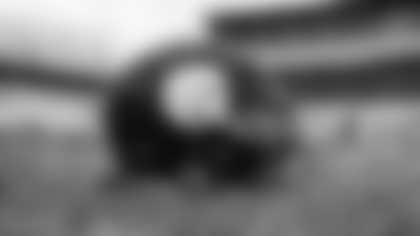It just got a little bit tougher to complete a pass in heaven. Johnny Unitas, Sammy Baugh, Otto Graham, and Norm Van Brocklin may have had the better of it for a while now up there, but as of Saturday, May 11, heaven's defensive backfield added a superstar, and an old nemesis of theirs.
Jack Butler, a Hall of Fame cornerback for the Pittsburgh Steelers, died on Saturday morning in a Pittsburgh hospital. He was 85.
Butler had entered the hospital in November 2012 when a lingering staph infection attacked an artificial knee replacement. His son, Mike, recently hired by the Steelers as a scout, told the Pittsburgh Post-Gazette that his father was completely lucid on Friday night and did not complain of any pain.
"His heart just stopped," Mike Butler told the newspaper.
A Pittsburgh native, Butler's initial career path seemed to be taking him to the priesthood. He entered the Carmelite junior seminary in Niagara Falls, Ontario, Canada, fresh from grammar school. Four years later, Butler entered the Carmelite novitate, which then was in New Baltimore, but at some point afterward he decided against the priesthood and enrolled at St. Bonaventure. It was there that Butler was introduced to football and embarked on a career in the sport that would span more than 50 years.
Undrafted by the NFL upon his graduation, the Steelers signed him, probably as a favor to Father Silas, the St. Bonaventure athletic director and Art Rooney Sr.'s brother. Butler somehow made the Steelers' roster as a rookie in 1951, and in the third game of the season an injury to Howard Hartley changed his life.
Butler began his Steelers career as a receiver, but rosters were often so thin that players were enlisted to play other positions as the need arose. Since Hartley was a defensive back, Coach John Michelosen's decision to send Butler into the game when Hartley was injured was a career-altering decision.
From there, Butler went on to play in 103 games during his nine seasons as a cornerback for the Steelers until a severe knee injury seven games into the 1959 season ended his playing career.
With 52 career interceptions, Butler ranked as the NFL's second all-time leader in interceptions when he retired after the 1959 season, behind Emlen Tunnell, and he also had 10 fumble recoveries. Butler's interception percentage is 50.5 (52 in 103 games), the best of any player in the Hall of Fame. Add in the fumble recoveries, and whenever Jack Butler took the field for a game with the Pittsburgh Steelers, 60.2 percent of the time he finished with at least one takeaway.
Butler returned the first of his 52 career interceptions for a 52-yard touchdown, and among the Hall of Fame quarterbacks he victimized during his career were Sammy Baugh, Johnny Unitas, Otto Graham, Y.A. Tittle, and Norm Van Brocklin, In 1957, Butler either intercepted a pass, forced a fumble, or recovered a fumble in 10 of the 12 games, and for his career he had nine multiple interception games.
Butler was voted to four Pro Bowls, he was an All-Pro defensive back three times, and he was named to the NFL's All-Decade Team of the 1950s.
"Jack was a tremendous player who ranked among the best in league history with his 52 interceptions while only playing in 12 games a year," said Steelers Chairman Dan Rooney. "He was a versatile player who was also used as a wide receiver, but his career ended unfortunately too soon with a bad knee injury. He was an excellent person both on and off the field, and he played an integral role in the BLESTO scouting program and our entire draft process before his retirement. His family was very close to the entire Rooney family, and he will be missed. Our condolences are with his family through this very tough time."
After his playing career ended following a severe knee injury in a 1959 game against the Philadelphia Eagles, Butler tried coaching, and the Buffalo Bills of the new American Football League hired him as an assistant. But the knee prevented Butler from doing the job the way he wanted to do it, and so he resigned, even refusing the salary that Bills owner Ralph Wilson offered to pay him nevertheless. There was a short stint with the Steelers as a scout, before Jack Butler's life in football would enter a different chapter.
It was in the early 1960s when three NFL teams – the Lions, Eagles, and Steelers – formed a scouting combine called LESTO (Lions, Eagles, Steelers Talent Organization). It would later add the Bears and come to be known as BLESTO, even today when many other teams have joined. Jack Butler served as BLESTO's executive director for 45 years, during which he scouted many outstanding players and trained almost as many future NFL scouts, general managers, and team presidents.
"Jack Butler was one of the all-time great Steelers," said President Art Rooney II. "He devoted his entire life to the NFL and made contributions to many teams and many players through his work with BLESTO and player personnel matters. Our condolences are with the entire Butler family."
In February 2012, Butler was elected into the Pro Football Hall of Fame, 53 years after his career ended and 48 years after he first became eligible. He had been on the ballot as one of two nominees of the Hall of Fame's Seniors Committee, which reviews the qualifications of players whose careers took place more than 25 years ago.
"Jack was a great person and great friend who always placed his faith and family first," said General Manager Kevin Colbert. "Beyond his great play on the field, he was a legendary personnel man who helped so many of us get established in our scouting careers. He will be missed, but never forgotten."






